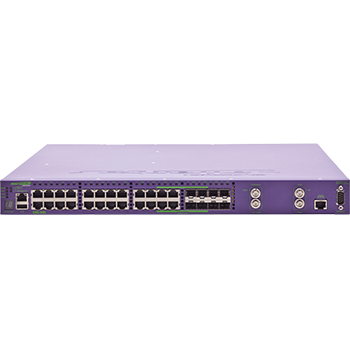- Hardware-based IEEE 1588v2 and ITU-TG.8262 Synchronous Ethernet for next-generation timing
- Resilient packet ring protocols including EAPS (Ethernet Automatic Protection Switching, RFC 3619) and ITU-T G.8032 Ethernet Ring Protection Switching
- 28 line-rate synchronous GbE ports
- Industry-standard pseudowires supporting up to 16 T1/E1 ports
- Hardware-based Ethernet OAM including IEEE 802.3ah, IEEE 802.1ag, and ITU Y.1731
- Modular ExtremeXOS® software with XML API
Extreme Networks E4G-400 Cell Site Aggregation Router
The Extreme Networks E4G-400 cell site aggregation router delivers Ethernet, IP/MPLS, and pseudowire capabilities in a compact 1RU form factor.
Extreme Networks E4G-400 cell site aggregation router is a new carrier-grade Ethernet platform, designed to enable true 4G mobile backhaul networks through three key capabilities – carrier-class resiliency, line-rate performance, and synchronization. This highly scalable cell site aggregation router enables mobile operators to manage and aggregate TDM and Ethernet services and their associated protocols onto a single, economical, and efficient Ethernet mobile backhaul network.
The E4G-400 is a cell site aggregation router providing up to 28GbE ports and six 10GbE ports in a 1RU form factor. Additionally, the E4G-400 router provides an optional 16-port T1/ E1 interface module to address the pseudowire capability that may be required at various points in the network (e.g., where 2G/3G cell towers are located in closer proximity to the cell site aggregation switch). The E4G-400 aggregation router offers services capacity as well as subscriber scalability through its line-rate GbE and 10GbE performance and support for IPv6 in hardware.
Multiple resilient GbE Ethernet Transport rings can be provisioned to support thousands of cell sites due to the line-rate performance and port density of the E4G-400, and through its support for EAPS and ITU-T G.8032. For end-to-end clock synchronization to deliver predictable multi-service performance, the E4G-400 router can be SyncE-enabled. IEEE 1588v2 is also supported, and one or both of these protocols can be utilized depending on the deployment scenario, giving mobile operators the flexibility to choose the option that best suits their needs.
- Compact 1RU size
- Industry-standard Pseudowires – Supports up to 16 ports
- Optional 10 Gigabit Ethernet Ports – Up to 6 ports
- Increased Gigabit Ethernet Ports – 28 active GbE ports
- Certified Synchronization – Both IEEE 1588v2 and SyncE
- Carrier-Grade Resiliency – Through EAPS (Ethernet Automatic Protection Switching, (RFC 3619) or ITU-T G.8032 Ethernet Ring Protection standard
- Integrated Ethernet OAM – Support for IEEE 802.3AH, IEEE 802.1AG, and ITU Y.1731
- Low latency for LTE
- Line rate performance

